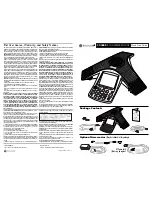
575
internal station number is dialed while performing a screened transfer, or during intercom calls. The
user calls the extension then dials the quick transfer dial access code (default = 8) and hangs up.
The call is placed in the mailbox and the caller hears the personal greeting.
Live Record
While on a CO/Trunk call, an extension user can have InMail record the conversation. The multiline
terminal user just presses the InMail Record key; the ESL user dials a code. Once recorded, the
Voice Messaging System stores the conversation as a new message in the
user’s mailbox. After
calling their mailbox, a user can save, edit or delete the recorded conversation. This feature is
supported only on CO, Tie, or DID calls. It is not supported on internal calls. The recording time
limit is set by multiplying Program 47-01-03 x 10 with a maximum recording limit of 65 minutes. At
the default (120 seconds) this will allow a 20 minute Live Recording message to be made. The
initial recording beep is controlled with Program 47-02-07. The repeating beep interval is controlled
with Program 45-01-06. Once Live Record is started, dialed DTMF digits are no longer sent to the
outside system for the duration of that call.
Live Monitor
A multiline terminal user can have their idle extension emulate a personal answering machine. This
lets InMail screen their calls, just like their answering machine at home. If activated, the extension
incoming calls route to the
user’s subscriber mailbox. The Live Monitor feature is supported for
external and internal calls. After the mailbox answers, the
user’s phone changes to show that a
caller is leaving a message, no audible tone is provided. The multiline terminal user can then:
Choose
Exit
to let the call go through to their mailbox.
Choose
ANSW
to intercept the call before it goes to their mailbox.
Choose
SCRN
to monitor the message being left by the caller.
Personal Answering Machine Emulation
A multiline terminal user can have their idle extension emulate a personal answering machine. This
lets In-Mail screen their calls, just like their answering machine at home. If activated, the
extension’s incoming calls route to the user’s subscriber mailbox. Once the mailbox answers, the
user hears the
caller’s incoming message. The multiline terminal user can then:
Let the call go through to their mailbox
Intercept the call before it goes to their mailbox
Voice Mail Overflow
If Voice Mail automatically answers trunks, Voice Mail Overflow can reroute those trunks to other
extensions when all Voice Mail ports do not answer or, with certain software, are busy. During
periods of high traffic, this prevents the outside calls from ringing Voice Mail for an inordinate
amount of time. There are two types of Voice Mail Overflow: Immediate and Delayed. With
immediate overflow, calls immediately reroute to other extensions when all Voice Mail ports do not
answer or, with certain software, are busy. With delayed overflow, calls reroute after a preset
interval. Without overflow, the outside calls ring Voice Mail until a port becomes available or the
outside caller hangs up.
Message Centre Mailbox
A Message Centre Mailbox is shared by more than one extension. Any multiline terminal that has a
Message Centre Key for the shared mailbox can:
Listen to the messages stored in the shared mailbox
Transfer calls to the shared mailbox
Use many other Voice Mail features previously available only at an extension individual mailbox
A Message Centre Mailbox helps co-workers that work together closely
– such as members of the
Summary of Contents for Univerge SV9100
Page 1: ... SV9100 Features and Specifications Manual Rev 1 2 March 2016 ...
Page 64: ...64 Required Component s None ...
Page 238: ...238 Walking Code Restriction 663 ...
Page 239: ...239 Temporary Code Restriction Override service code be changed 775 ...
Page 285: ...285 Single Line Telephone 1 Lift the handset A fast busy is heard 2 Dial 759 3 Hang up ...
Page 332: ...332 Circular Routing Department Calling Circular Routing CALL 1 CALL 2 CALL 3 CALL 4 ...
Page 406: ...406 Trunk Distinctive Ringing Flow Chart ...
Page 407: ...407 ICM Distinctive Ringing Flow Chart ...
Page 442: ...442 CCIS Standard Calls ...
Page 447: ...447 CCIS VE Standard Calls ...
Page 456: ...456 CPN sent when making a 911 call across CCIS trunks from a terminal ...
Page 461: ...461 CCIS VE 911 Calls ...
Page 637: ...637 Cascade Message Notification Flow Chart 1 ...
Page 638: ...638 Cascade Message Notification Flow Chart 2 ...
Page 639: ...639 Cascade Message Notification Flow Chart 3 ...
Page 655: ...655 Cascade Message Flow Chart 1 ...
Page 808: ...808 DTI U40 ETU Programming Flowchart for ISDN PRI Answering Calls the GCD PRTA Overlap ...
Page 813: ...813 ...
Page 844: ...844 None Related Features None Guide to Feature Programming None Operation None ...
Page 915: ...915 Communications Interface feature for more ...
Page 916: ...916 ...
Page 917: ...917 Operation None ...
Page 948: ...948 Operation Normal call handling procedures for single line telephones apply ...
Page 1015: ...1015 Related Features None Guide to Feature Programming None Operation None ...
Page 1026: ...1026 Operation Refer to Central Office Calls Answering ...
Page 1030: ...1030 Multiline Room Monitoring ...
Page 1031: ...1031 Single Line Telephone Room Monitoring ...
Page 1146: ...1146 SMDR Flowchart Continued ...
Page 1147: ...1147 SMDR Flowchart Continued ...
Page 1371: ...1371 ...
Page 1400: ...1400 To answer off hook signaling 2nd call and 2nd caller disconnect the call NOTE ...
Page 1402: ...1402 SV9100 Features and Specifications Manual NEC Enterprise Solutions ...
















































